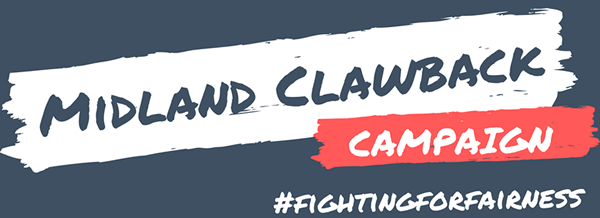
History explained
The campaign committee was created to help fight for fairness. We have recently built a new website and social media presence and use the #fightingforfairness hashtag.
The History, the term ‘Clawback’ is a complicated subject, so on this page we tried to explain things in a clear and concise and easy to follow please let us know if you have any further questions or would like items clarified and we will do our best to get back to you. Email or visit our contact us page to ask a question?
What is Clawback ?
Clawback is a deduction from pension made by the bank when you reach state pension age.
The history, Clawback was introduced under pensions law in 1948. Midland Bank introduced clawback to its DBS pension scheme in 1975, nearly 30 years later, as a cost saving measure.
Staff Handbooks in the 1970s and 1980s make little or no reference to clawback, simply saying there is a non-contributory final salary pension scheme and details are available in scheme rules handbook, available from regional management centres, or occasionally claimed to be available in each branch.
Annual pension statements, which had a projected financial figure for “state deduction” were not introduced until the 1990s. In the meantime, a State Pension top up, SERPS, was introduced in 1978 and Midland Bank opted the entire scheme out of this. Many scheme members subsequently thought “state deduction” referred to being contracted-out of SERPS.
Confusion.
Why is so unfair?
Bank pension is based on salary paid, in simple terms 1/60th of final salary for each year of service.
Clawback is based on State Pension at 1/80ths x years’ service x the average State Pension over the 52 weeks prior to leaving the scheme (leaving the bank or retirement). There is no link to salary nor to pension received. Years’ service figure stopped increasing from 30 June 2009.
Thus 2 members of staff with the same service record might retire with very different pensions. A senior manager might retire on £100,000 a year whilst a junior member of staff on £10,000 a year. However, clawback deduction would be the same, say £2,500 a year. This is only 2.5% of pension lost for the senior manager but a massive 25% for the junior member of staff. Employment policies of the 1970s and 1980s resulted in the majority of lower paid staff being women.
The bank have admitted clawback would have been introduced as a cost saving measure (UK CEO Ian Stuart). The cost of providing the £100,000 pension would have been much greater than the £10,000 pension. However, both pensioners suffer the same cost saving deduction.
That is not fair.
Why Wont HSBC Fix this?
The bank say the cost of removing clawback is £450M. At the end of 2017 the HSBC UK Pension Fund had a surplus of over £2.5Bn. The HSBC adjusted pre-tax profit for 2018 was $21.7Bn. Removing clawback is affordable.
The bank says it cannot change one section of the overall pension fund without changing them all. However, they have changed just this section many times in the past. This is the only section that suffers the unfair and inequal clawback penalty.
This can be changed.
The legal and Government background
State Pension Integration, or Clawback, or State Deduction was introduced alongside the State Pension in 1948 (1946 National Insurance Act), as was National Insurance (NI) and the National Health Service.
To help employers who already offered a pension scheme mitigate this new extra cost of NI, the law allowed them to introduce a reduction in the pension they paid when employees reached state pension age. That meant employers did not need to pay so much into their pension funds. This is State Pension Integration or Clawback.
Midland Bank (now HSBC) decided to introduce clawback in 1975 as a cost saving move.
In 1978 Midland Bank elected to opt out of the new SERPS, which was a State Pension top up. A further cost saving move, which they argued was right given that they offered a final salary DBS and employees qualified for the basic State Pension.
Midland Bank, was not the only employer to impose clawback on its DBS pension scheme members. However a House of Commons Library briefing refers to pension industry surveys in 2002 and 2005: the 2002 survey apparently reports that 60% of DBS schemes did not suffer clawback. The 2005 survey says that 70% of open DBS schemes make no clawback deduction. This suggests that many schemes did not have or dropped clawback and certainly suggests that it is a minority of schemes that have a clawback penalty.
Within the banking industry, we understand that National Westminster, Clydesdale, The Post Office, the Co-Operative Bank and the Bank of England have either never had a clawback penalty, have dropped it or severely capped any clawback.
Some Public service schemes included State Pension Integration, giving a reduction in pensions at State Pension age, until this clawback was abolished from these schemes in 1980.
On 16 November 2017, then Pensions Minister Guy Opperman said they had received a number of representations on the HSBC scheme and its clawback policy. Such arrangements were set in scheme rules, and it would not be right to compel company schemes to withdraw them. The decision must be the choice of the company and its workforce.






